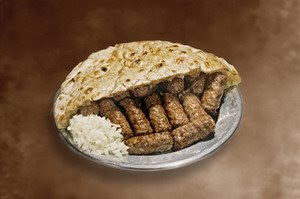 Baščaršija (Old Town)
Baščaršija (Old Town) 
We enjoyed our two days exploring Sarajevo, and the fact that we didn’t know much about the place or what to expect added to the excitement. The weather was fine, although the chill in the air signalled the altitude and the coming winter. A thin mist hung in the sky above the city and its enclosing hills, softening the autumnal sunshine which slanted onto the streets and parks.
Sarajevo has a bustling, cosmopolitan atmosphere, and wandering around the old town, with its markets and minarets, cobbled streets and coffee shops, the visitor is struck by the feeling of being at the crossroads of east and west. Which Sarajevo always has been. Having being part of the Ottoman and Austro-Hungarian empires, then communist Yugoslavia, it now is the capital of the independant state of Bosnia-Herzegovina.


 While wandering in the Baščaršija neighborhood we came across the Gazi Husrev-Beg Mosque, often referred to as the Beg's Mosque. Built in 1531, it is considered one of the world's finest examples of Ottoman architecture.
While wandering in the Baščaršija neighborhood we came across the Gazi Husrev-Beg Mosque, often referred to as the Beg's Mosque. Built in 1531, it is considered one of the world's finest examples of Ottoman architecture. Washing fountain, Gazi Husrev-Beg Mosque
Washing fountain, Gazi Husrev-Beg MosqueIt was here on 1914 that an act of nationalist-inspired rebellion occurred that was to have massive and catastrophic consequences for the world. In the event that triggered World War I, Archduke Franz Ferdinand of Austria, the heir to the Hapsburg throne, and his wife Sophie, were assassinated on 28 June 1914 by a Serb, Gavrilo Princip. The building outside of which Princip fired the shots is now a museum of Sarajevo during the Austro-Hungarian period, including information on the assassination.

As well as learning about Sarajevo's hisotry, we also got to sample some Bosnian delicacies, such as Bosnian Coffee:


The city appears to have largely recovered from the devastating siege of 1992 to 1996, although many buildings still bear the scars of mortar and tank bombardment. The siege was fought between the defending forces of the Bosnian Government, who had declared independence from Yugoslavia, and the Yugoslav People's Army (JNA) and Bosnian Serb forces located in the surrounding hills. It is estimated that more than 12,000 people were killed and 50,000 were wounded during the siege. The residents endured harsh living conditions during the 4 year siege, having no electricity or running water and living from rations flown in by the UN.

We took a tour to visit the tunnel dug by the Bosnians during the siege to ferry people and supplies in and out of the surrounded city. The tunnel went underneath the airport to the free Bosnian territory on the other side. The tunnel was one of the major ways of bypassing the international arms embargo (which was applied to all parties to the Bosnian conflict, including the defenders of Sarajevo) and providing the city defenders with weaponry.



On our last morning in Sarajevo we visited Svrzina kuca (Svrzo house), a beautiful old Ottoman house built in the 18th century that shows how wealthy families would have lived in that time.









1 comment:
top [url=http://www.001casino.com/]casino bonus[/url] hinder the latest [url=http://www.realcazinoz.com/]casino bonus[/url] autonomous no consign bonus at the best [url=http://www.baywatchcasino.com/]online casino
[/url].
Post a Comment